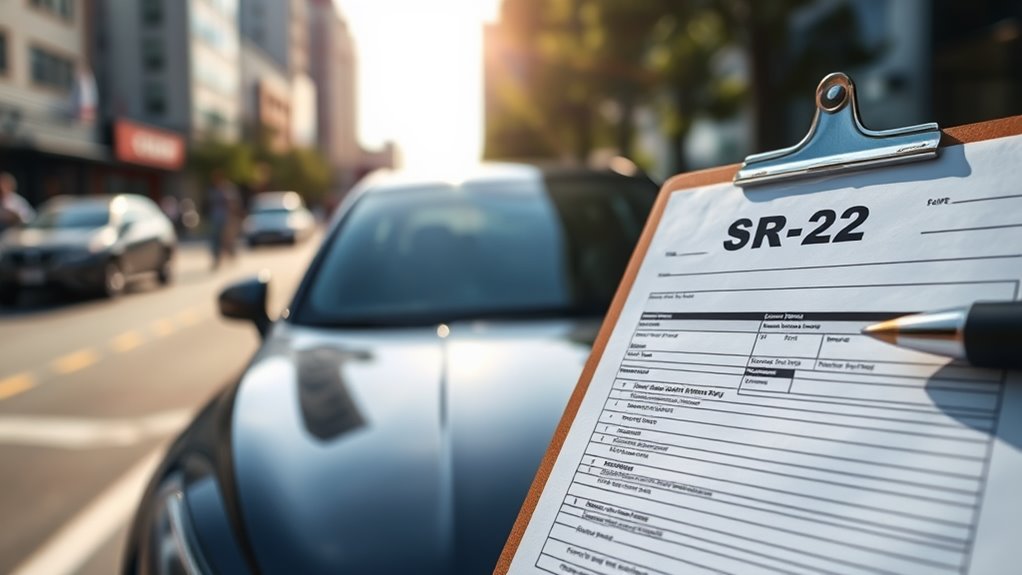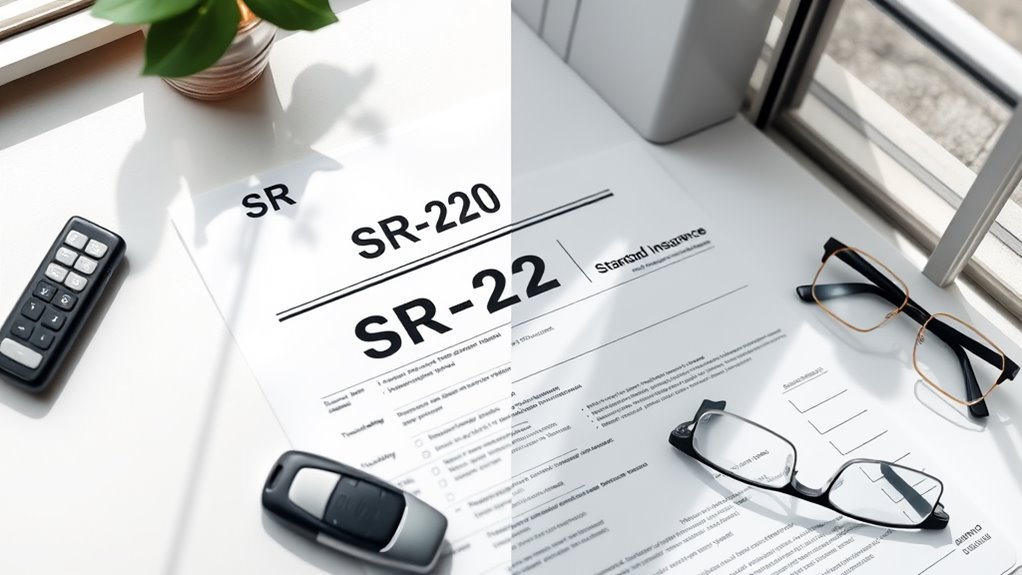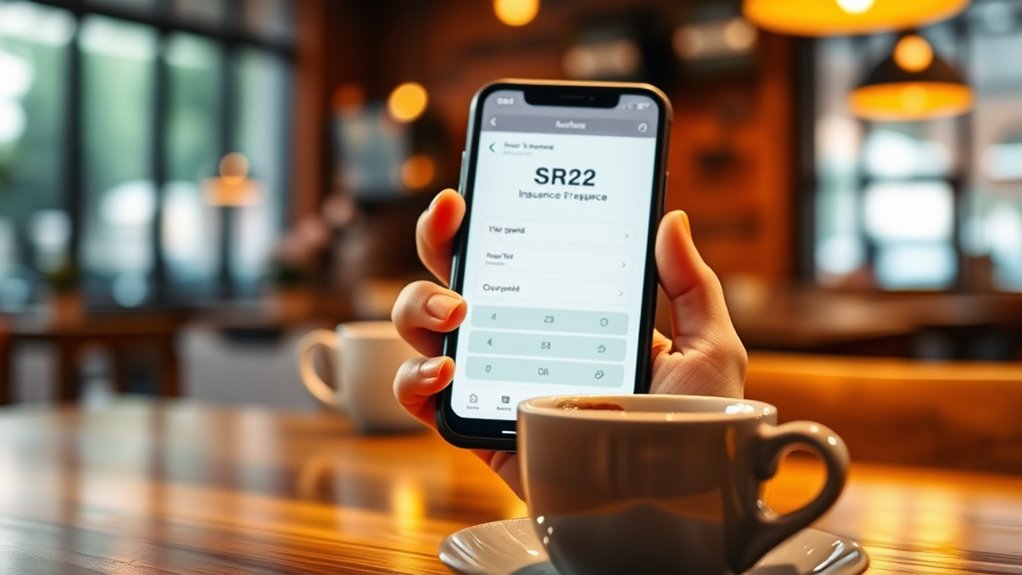Sr-22 Insurance
When it comes to maneuvering through the complexities of auto insurance, having an SR-22 can feel like a necessary bump in the road. If you’ve faced serious traffic violations, you might find yourself needing this form of proof for financial responsibility. Understanding who needs it and how it impacts your insurance can be vital. You may be surprised at the implications and requirements surrounding SR-22 insurance. What happens if you let your coverage lapse?
Key Takeaways
- SR-22 insurance is a document required for high-risk drivers to prove financial responsibility after serious traffic offenses.
- It is not a separate policy but an addendum to an existing insurance policy, typically needed for 1 to 5 years.
- Drivers may need an SR-22 after DUIs, license suspensions, or multiple traffic violations, with continuous coverage essential.
- Filing fees range from $15 to $50, and premiums can increase by $400 to $1,000 depending on driving history.
- Alternatives include cash bonds or FR-44 coverage, which has higher liability limits for specific DUI offenses.
What Is SR-22 Insurance?

SR-22 insurance is an essential document for drivers deemed high-risk due to serious traffic offenses. It serves as proof of financial responsibility, demonstrating that you meet your state’s minimum liability coverage requirements. While it’s not a separate insurance policy, it acts as an addendum to your current policy, ensuring compliance with state regulations. Typically required for three to five years, the filing process involves your insurance provider submitting the SR-22 to the state DMV. Some states may allow this filing to replace large cash deposits. Be aware that not all insurers handle SR-22 filings, and having one can increase your premiums. Keeping your SR-22 active is vital, as lapses can lead to license suspension. Additionally, maintaining continuous insurance coverage is crucial to avoid penalties and ensure your driving privileges are reinstated.
Who Needs an SR-22?
Certain drivers find themselves needing an SR-22 due to specific circumstances that indicate a higher risk on the road.
If you’ve had a DUI conviction, failed to request a DMV hearing, or experienced a license suspension, an SR-22 is often required to reinstate your driving privileges.
You may also need one if you’re involved in an uninsured accident or declared a negligent operator due to excessive traffic violations.
Additionally, non-owner drivers or those frequently driving vehicles not owned by them must secure SR-22 coverage.
If a court mandates it, you’ll need to comply. Minimum liability insurance requirements must also be met to ensure you are financially responsible on the road.
How Long Is an SR-22 Required?
How long will you need to maintain an SR-22? The duration typically varies by state, generally ranging from 1 to 3 years, depending on your situation.
The duration for maintaining an SR-22 varies by state, typically lasting between 1 to 3 years.
Here are some key points to take into account:
- Wisconsin: Requires a minimum of 3 years for OWI offenses.
- DUI: Most first-time convictions demand a 3-year SR-22 period.
- Compliance: Continuous coverage without lapses is vital; any break restarts the clock.
- Extensions: Additional violations could extend your SR-22 mandate.
Your insurance provider submits the SR-22 directly to the DMV.
Differences Between SR-22 and Other Insurance Forms

When comparing SR-22 to other financial responsibility forms like FR-44 or SR-26, it’s essential to understand their specific requirements and implications.
SR-22 is often required in more states and serves as proof of insurance, while FR-44 mandates higher liability limits in states like Virginia and Florida.
Additionally, unlike standard insurance policies, SR-22 isn’t an insurance plan itself but a certification attached to your existing policy.
SR-22 vs. FR-44
While both SR-22 and FR-44 serve to certify financial responsibility following driving violations, they cater to different situations. Understanding these differences can help you navigate your insurance needs.
- SR-22: Required for non-alcohol-related offenses like reckless driving.
- FR-44: Specific to DUI/DWI offenses, often for multiple alcohol-related convictions.
- Coverage: SR-22 matches state minimums; FR-44 demands higher liability limits.
- Availability: SR-22 is common in most states; FR-44 is limited to Florida and Virginia.
Both forms require continuous coverage, and lapses can lead to license suspension.
Expect higher premiums with FR-44 due to its strict requirements. Knowing which form you need is essential for maintaining your driving privileges and managing costs effectively.
SR-22 vs. SR-26
Understanding the differences between SR-22 and SR-26 is vital for anyone maneuvering the complexities of high-risk insurance requirements.
An SR-22 verifies that you maintain active insurance after significant violations like DUIs, while an SR-26 cancels or terminates that filing, indicating compliance or an insurance lapse.
The SR-22 is state-mandated for license reinstatement, lasting 3-5 years, whereas the SR-26 is an insurer-initiated notification to the DMV.
Timely filing of an SR-26 is essential to avoid penalties.
While SR-22s can lead to increased premiums, SR-26s may help reduce rates once you meet compliance.
SR-22 vs. Insurance Policies
The SR-22 serves a specific function in the domain of high-risk insurance, setting it apart from traditional insurance policies. It acts as documentation for minimum liability coverage rather than offering direct insurance.
Here are key differences to take into account:
- SR-22s are filed with the DMV, while traditional policies provide actual coverage.
- They’re often required for high-risk drivers, unlike standard policies.
- SR-22s don’t cover extensive or collision insurance.
- States may have different minimum liability requirements for SR-22s compared to regular policies.
Understanding these differences is important when steering through your insurance options, especially if you’re deemed a high-risk driver.
State Variations in SR-22 Requirements
When it comes to SR-22 requirements, you’ll find that regulations vary considerably from state to state.
Some states impose different durations for maintaining the SR-22, while others may offer alternatives for demonstrating financial responsibility.
Understanding these variations is essential for ensuring compliance and avoiding penalties.
State-Specific Regulations
While steering through the complexities of SR-22 insurance, it’s crucial to recognize that state-specific regulations can greatly impact your requirements and obligations. Each state has its own rules regarding duration and coverage, so you need to stay informed.
- Some states, like Connecticut and North Dakota, require a minimum of one year.
- Others, like Texas and Iowa, mandate two years.
- Florida’s FR-44 has stricter coverage requirements than the standard SR-22.
- Legal triggers for needing an SR-22 can include DUI convictions or at-fault accidents without insurance.
Understanding these differences can help you navigate your insurance needs effectively and avoid potential penalties for non-compliance.
Always double-check your state’s specific requirements to stay on the right track.
Duration of Requirements
Maneuvering the duration of SR-22 requirements can be tricky, as each state has its own specific mandates that can range from one to three years.
For instance, Texas requires two years from the conviction date, while Illinois extends this to three years for serious violations.
California links the duration to the license suspension period, often resulting in three years.
Vermont’s timeframe remains unclear but generally falls within the same range.
Remember, the requirement starts from the date of the offense or conviction.
If you let your coverage lapse, most states restart the clock.
Always keep your insurer notified of any changes, as gaps can lead to penalties and extended compliance periods.
Financial Responsibility Alternatives
Understanding your options for financial responsibility can greatly ease the burden of SR-22 requirements. States often provide alternatives tailored to specific circumstances, allowing you to navigate your situation effectively.
Here are some alternatives you might consider:
- FR-44 Form: Required in Florida and Virginia, this demands higher liability coverage.
- Non-Owner Insurance: Ideal for those who drive but don’t own a vehicle.
- High-Risk Auto Insurance: Available for drivers with poor records seeking coverage.
- SR21 Form: Used to show adequate coverage post-minor accidents.
Keep in mind that each state has unique requirements, so it’s important to check local regulations to verify you’re meeting all financial responsibility obligations.
Impact of SR-22 on Driving Privileges
The impact of an SR-22 on your driving privileges can be significant, especially if you fail to maintain the required coverage. If your SR-22 lapses, your driving privileges could be suspended, leading to increased scrutiny on your driving record.
During the SR-22 period, states and insurance companies monitor your compliance closely, and any additional violations can result in quicker license suspension. Furthermore, insurance companies are obligated to notify the DMV if your SR-22 coverage is no longer valid.
This means you must stay vigilant about your insurance status to avoid penalties and potential extensions of your SR-22 requirement. Ultimately, maintaining an active SR-22 is essential for protecting your driving privileges and avoiding further legal complications.
How to Obtain an SR-22

After recognizing the significant impact an SR-22 can have on your driving privileges, it’s important to know how to obtain one if required.
Understanding the implications of an SR-22 is crucial for maintaining your driving privileges.
Start by following these steps:
- Get Notified: Wait for the state DMV to inform you if an SR-22 is necessary.
- Contact Insurance: Reach out to an auto insurance provider to initiate the SR-22 process.
- Check Eligibility: Verify your insurer offers SR-22 filings; you may need to switch providers.
- Maintain Coverage: If uninsured, purchase a new policy that meets your state’s minimum liability requirements.
Costs Associated With SR-22 Insurance
While steering through the complexities of SR-22 insurance, you’ll find that costs can vary greatly based on several factors, including your state, driving history, and the insurance provider you choose.
Typically, the SR-22 filing fee ranges from $15 to $50, while annual premiums can spike by $400 to $1,000. For instance, in Ohio, premiums range from $300 to $800, depending on your driving record. A clean record can keep costs around $1,596, but infractions like DUIs can push it to about $3,744.
Additionally, younger drivers often face higher premiums, and rates differ considerably among insurance companies. Therefore, shopping around and comparing multiple options is essential to secure the best price for your SR-22 insurance.
Maintaining Compliance With SR-22 Requirements
Maintaining compliance with SR-22 requirements is essential to keeping your driving privileges intact. To guarantee you meet these obligations, follow these steps:
- Keep your insurance policy active throughout the required period.
- Notify your insurance provider of any changes that could affect your coverage.
- Regularly check for compliance reports from your insurer to avoid surprises.
- Understand your state’s specific SR-22 regulations, as they can vary.
Failing to maintain your SR-22 can lead to severe consequences, including license suspension and additional fines.
Failure to uphold your SR-22 requirements may result in serious penalties, such as losing your license and incurring extra fines.
Remember, your insurance company will file the SR-22 form, but it’s your responsibility to guarantee continuous coverage.
Stay proactive, and you’ll navigate the SR-22 process more smoothly.
Alternatives to SR-22 Insurance

If you’re looking for alternatives to SR-22 insurance, consider cash bond options that can satisfy state requirements without traditional coverage.
In states like Florida and Virginia, the FR-44 might be a better fit, as it has different coverage limits than SR-22.
Exploring these alternatives can offer you flexibility while meeting legal obligations.
Cash Bond Options
Many drivers seek alternatives to SR-22 insurance, and cash bonds present a viable option in several states. By depositing a specific amount with state authorities, you can demonstrate financial responsibility without traditional insurance.
Here are some key points about cash bonds:
- State-Specific Amounts: For example, Illinois requires a $70,000 deposit.
- Flexibility: Cash bonds can often be fulfilled with cash or securities.
- Duration: The bond must stay in place as long as the state requires proof of financial responsibility.
- Cost Implications: While it ties up funds, it avoids ongoing premiums associated with SR-22 insurance.
Choosing a cash bond could offer a practical path to fulfill your state’s requirements while managing your finances effectively.
FR-44 Coverage Requirements
Cash bonds offer a practical alternative to SR-22 insurance, but for drivers facing DUI convictions or severe violations, FR-44 coverage becomes a necessary requirement.
Unlike SR-22, which applies to minor offenses, FR-44 mandates higher liability limits, doubling Virginia’s standard minimums and greatly increasing costs. For instance, Florida requires $100k bodily injury per person and $300k per accident, while Virginia’s thresholds are $60k and $120k, respectively.
Coverage must be maintained for at least three consecutive years, and any lapse can trigger immediate license suspension. Insurers file FR-44 directly with state DMVs, ensuring compliance.
As a high-risk driver, expect your premiums to rise, often doubling or tripling due to these strict regulations and coverage requirements.
Frequently Asked Questions
Can I Drive Without an SR-22 if I Have a Suspended License?
You can’t drive with a suspended license. Doing so is illegal and can lead to harsher penalties. If you need your license reinstated, you’ll typically have to meet specific requirements, including insurance verification.
What Happens if My SR-22 Is Canceled Before the Requirement Ends?
If your insurance lapses, you risk immediate license suspension and hefty fines. For example, if you’re caught driving without coverage, you’ll face legal penalties, higher premiums, and difficulties obtaining future insurance. Stay compliant to avoid complications.
Can I Switch Insurance Companies While Having an SR-22?
Yes, you can switch insurance companies while having an SR-22. Just guarantee the new insurer files a new SR-22 before the old one expires, maintaining continuous coverage throughout the process. Notify both companies about the change.
Does an SR-22 Affect My Insurance Premiums?
Yes, an SR-22 can greatly impact your insurance premiums. It indicates higher risk due to past violations, often leading to increased rates. Your premium may decrease once you fulfill the SR-22 requirement and maintain a clean record.
How Do I Know if I Need an SR-22?
If you’ve faced serious driving issues like a license suspension or multiple violations, it’s wise to check with your state’s DMV. They’ll clarify whether you need specific proof of financial responsibility moving forward.
Conclusion
Maneuvering the world of SR-22 insurance can feel overwhelming, but understanding its requirements is essential for your driving future. On one hand, it’s a necessary step to regain your driving privileges after serious violations; on the other, it can be a financial burden. By staying informed and compliant, you can turn a challenging situation into an opportunity for responsible driving. Remember, maintaining continuous coverage is key to moving forward without additional penalties or extended obligations.










